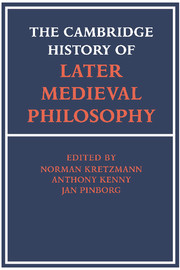 The Cambridge History of Later Medieval Philosophy
The Cambridge History of Later Medieval Philosophy Book contents
- Frontmatter
- Introduction
- I Medieval philosophical literature
- II Aristotle in the middle ages
- III The old logic
- IV Logic in the high middle ages: semantic theory
- 7 The origins of the theory of the properties of terms
- 8 The Oxford and Paris traditions in logic
- 9 The semantics of terms
- 10 The semantics of propositions
- 11 Syncategoremata, exponibilia, sophismata
- 12 Insolubilia
- 13 Speculative grammar
- V Logic in the high middle ages: propositions and modalities
- VI Metaphysics and epistemology
- VII Natural philosophy
- VIII Philosophy of mind and action
- IX Ethics
- X Politics
- XI The defeat, neglect, and revival of scholasticism
- Index nominum
- Index rerum
- References
7 - The origins of the theory of the properties of terms
from IV - Logic in the high middle ages: semantic theory
Published online by Cambridge University Press: 28 March 2008
- Frontmatter
- Introduction
- I Medieval philosophical literature
- II Aristotle in the middle ages
- III The old logic
- IV Logic in the high middle ages: semantic theory
- 7 The origins of the theory of the properties of terms
- 8 The Oxford and Paris traditions in logic
- 9 The semantics of terms
- 10 The semantics of propositions
- 11 Syncategoremata, exponibilia, sophismata
- 12 Insolubilia
- 13 Speculative grammar
- V Logic in the high middle ages: propositions and modalities
- VI Metaphysics and epistemology
- VII Natural philosophy
- VIII Philosophy of mind and action
- IX Ethics
- X Politics
- XI The defeat, neglect, and revival of scholasticism
- Index nominum
- Index rerum
- References
Summary
Language, thought, and reality
Beginning as early as the eleventh century, the relationship between thought and language was a focal point of medieval thought. This does not amount to saying that the basic nature of that relationship was being studied; rather it was accepted without discussion, as it had been in antiquity. Thought was considered to be linguistically constrained by its very nature; thought and language were taken to be related both to each other and to reality in their elements and their structure. In the final analysis, language, thought, and reality were considered to be of the same logical coherence. Language was taken to be not only an instrument of thought, expression, and communication but also in itself an important source of information regarding the nature of reality. In medieval thought, logico-semantic and metaphysical points of view are, as a result of their perceived interdependence, entirely interwoven.
The first medieval scholars to have a professional interest in language as such were the grammarians. Their interest was focused on what we would call logico-semantical and syntactical questions; this is especially true of the School of Chartres as early as the 1030s. No longer were words studied as separate units quite apart from their linguistic context; rather it was that context itself that attracted the most intense interest. I have labelled this concentration of attention the ‘contextual approach’ (De Rijk 1967, pp. 113–17; 123–5). The statement (proposition), not isolated words, was taken to be the fundamental unit of meaning.
- Type
- Chapter
- Information
- The Cambridge History of Later Medieval PhilosophyFrom the Rediscovery of Aristotle to the Disintegration of Scholasticism, 1100–1600, pp. 159 - 173Publisher: Cambridge University PressPrint publication year: 1982
References
- 26
- Cited by
